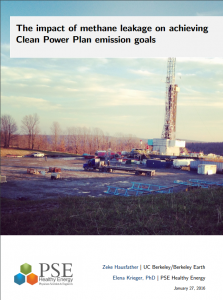Full Title: The impact of methane leakage on achieving Clean Power Plan emission goals
Author(s): Zeke Hausfather and Elena Krieger
Publisher(s): PSE Health Energy
Publication Date: January 1, 2016
Full Text: Download Resource
Description (excerpt):
The EPA’s Clean Power Plan aims to cut 32% of power sector greenhouse gas emissions by 2030, for the first time regulating climate pollutants from the sector responsible for the largest portion of these emissions. However, if upstream methane emissions are not taken into consideration, these efforts may fall far short of achieving real reductions of this magnitude across the lifecycle of electricity generation. The EPA has projected that CO2-equivalent (CO2e) emissions from electricity generation will fall to 32% below 2005 levels under the Plan, but attributes nearly half of those reductions to historic coal-to-gas switching between 2005-2013, and projects continued switching in the coming years. However, this calculation does not reflect the full climate impact of methane leakage across the natural gas system, which erodes the climate benefits of switching to gas.
Methane is a much more powerful greenhouse gas than CO2, and numerous recent scientific studies have found leakage rates to be much higher than reflected in the EPA’s Greenhouse Gas Inventory. Here, we consider the impact of methane leakage rates from 1-6% on achieving the Plan’s targets, reflecting these recent scientific findings. While the 32% emission target is achieved under the low leakage rate of 1.5% found in the Inventory, the EPA’s Clean Power Plan compliance scenarios only reduce emissions by about 28-29% at a 4% leakage rate when using the 100-year global warming potential for methane; using a 20-year timeframe and 4% leakage, the emission reductions under these compliance scenarios are only 22-23%. The upper limit of our leakage range, at 6%, brings these reductions below 20%. We next introduce two scenarios with higher renewable energy mixes: in the first we deploy the full renewable energy potential calculated by the EPA, and in the second we assume that the maximum historic annual growth rate of renewables is achieved every year beginning in 2020. We find that even with high methane leakage rates, the Plan’s targets can be achieved or even surpassed by adopting such renewable-based energy mixes. This finding suggests that reducing the climate impact of electricity generation requires a greater focus on curbing upstream methane leakage rates or, even more reliably, that state implementation plans encourage the continued growth of renewables to match these historic national deployment rates.
